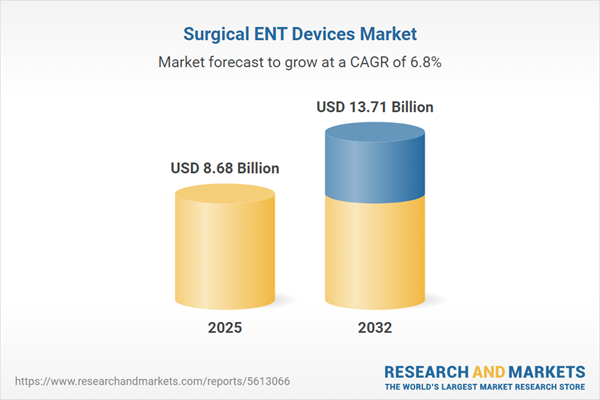Speak directly to the analyst to clarify any post sales queries you may have.
The surgical ENT devices market is at a pivotal stage, shaped by rapid technology advancements and shifts in healthcare delivery. Senior leaders are adopting integrated solutions to optimize clinical outcomes, address operational challenges, and maintain compliance in an evolving regulatory landscape.
Market Snapshot: Surgical ENT Devices Market
As of 2024, the global surgical ENT devices market stands at USD 8.13 billion and is projected to reach USD 8.68 billion in 2025, advancing to USD 13.71 billion by 2032. This growth reflects a compound annual growth rate (CAGR) of 6.75%. Driving factors include the widespread adoption of minimally invasive surgical technologies, advancements in digital diagnostics, and ongoing enhancements in surgical instruments that streamline procedural efficiency. Senior decision-makers are steering investments in these innovations to align with evolving care delivery models, accommodate growing procedural volumes, and strengthen safety standards. The continued prioritization of workflow digitalization, along with infrastructure optimization, underscores the market’s focus on sustainable operational gains.
Surgical ENT Devices Market Scope & Segmentation
- Device Types: Flexible and rigid endoscopes, video-endoscopes, laser therapy systems, surgical microscopes, radiofrequency instruments, tissue shavers, and surgical staplers are utilized across otolaryngology interventions. Their versatility addresses both routine procedures and complex surgical demands.
- Applications: Devices are integral to the management of allergic rhinitis, sinus and ear pathologies, laryngectomy, balloon sinuplasty, rhinoplasty, septoplasty, tonsil removal, and adenoid removal. This wide application spectrum streamlines patient workflows and supports multidisciplinary care teams.
- End Users: Ambulatory surgical centers, hospital operating rooms, and ENT specialist clinics rely on these devices for procedural consistency, expedited care delivery, and reduced turnaround times, reinforcing their value across diverse clinical environments.
- Technologies: Deployment of laser systems, mechanical and ultrasonic platforms, and radiofrequency modalities enable precision, real-time image guidance, and the ability to address increasing procedure complexity.
- Distribution Channels: Devices reach end users via direct hospital tenders as well as broad distributor networks, supporting robust procurement operations and enabling adaptation to shifting purchasing environments globally.
- Regions: The market spans the Americas, Europe, Asia-Pacific, and Middle East & Africa. Regional initiatives in the United States, China, Germany, and India are driving targeted growth, with stakeholders navigating local regulations and aligning offerings with unique market adoption patterns.
- Leading Companies: Industry development is spearheaded by established players including Medtronic, Olympus Corporation, Stryker, Smith & Nephew, KARL STORZ, B. Braun, CONMED, Bausch Health, Richard Wolf GmbH, and Johnson & Johnson, maintaining momentum through R&D, strategic alliances, and advancing technology portfolios in high-opportunity regions.
Key Takeaways for Senior Decision-Makers
- Advanced surgical ENT devices promote standardization and consistent procedural outcomes in healthcare settings, supporting better resource allocation and streamlined care.
- Adoption of minimally invasive and image-guided techniques is elevating patient-centric treatment while improving surgical workflow efficiency and safety.
- Procurement teams increasingly emphasize comprehensive device evaluation, focusing on quality, risk management, and adherence to evolving regulatory guidelines.
- Robust inventory management paired with adaptive sourcing strategies helps healthcare providers counteract supply variability, safeguarding continuity of patient care.
- Strategic investments in digital imaging and real-time data solutions facilitate progressive workflow enhancements, responding to changes in care delivery demands.
- Operational efforts focus on optimizing resources and long-term cost control to drive sustainable patient satisfaction and overall organizational performance.
Tariff Impact and Strategic Adaptation
With new U.S. tariffs affecting select imported surgical ENT devices and components, healthcare organizations face increased procurement costs. Manufacturers are responding by refining contract terms, emphasizing domestic sourcing, and forming partnerships with local suppliers. In parallel, healthcare providers and distributors are reevaluating purchasing strategies and fortifying supply chain frameworks to maintain consistent device access and reduce exposure to regulatory disruptions.
Methodology & Data Sources
The analysis draws from comprehensive secondary research and structured interviews with clinical, procurement, and technological stakeholders. Methodological tools include SWOT analyses, supply chain reviews, targeted surveys, and case studies, together supporting informed decision-making at the senior leadership level.
Why This Surgical ENT Devices Report Matters
- Provides actionable recommendations to help executives synchronize capital planning and operational strategies with the latest surgical ENT devices technologies.
- Enables proactive adaptation by highlighting risks and best practices for navigating procurement changes and regulatory updates, strengthening supply chain resilience.
- Informs senior leadership on driving digital transformation and maintaining high clinical standards throughout patient care processes.
Conclusion
This report equips senior executives with practical insights to drive technology integration and organizational flexibility, supporting effective strategies in the fast-evolving surgical ENT devices market.
Additional Product Information:
- Purchase of this report includes 1 year online access with quarterly updates.
- This report can be updated on request. Please contact our Customer Experience team using the Ask a Question widget on our website.
Table of Contents
3. Executive Summary
4. Market Overview
7. Cumulative Impact of Artificial Intelligence 2025
Companies Mentioned
The companies profiled in this Surgical ENT Devices market report include:- Medtronic plc
- Olympus Corporation
- Stryker Corporation
- Smith & Nephew plc
- KARL STORZ SE & Co. KG
- B. Braun Melsungen AG
- CONMED Corporation
- Bausch Health Companies Inc.
- Richard Wolf GmbH
- Johnson & Johnson
Table Information
| Report Attribute | Details |
|---|---|
| No. of Pages | 198 |
| Published | October 2025 |
| Forecast Period | 2025 - 2032 |
| Estimated Market Value ( USD | $ 8.68 Billion |
| Forecasted Market Value ( USD | $ 13.71 Billion |
| Compound Annual Growth Rate | 6.7% |
| Regions Covered | Global |
| No. of Companies Mentioned | 11 |









